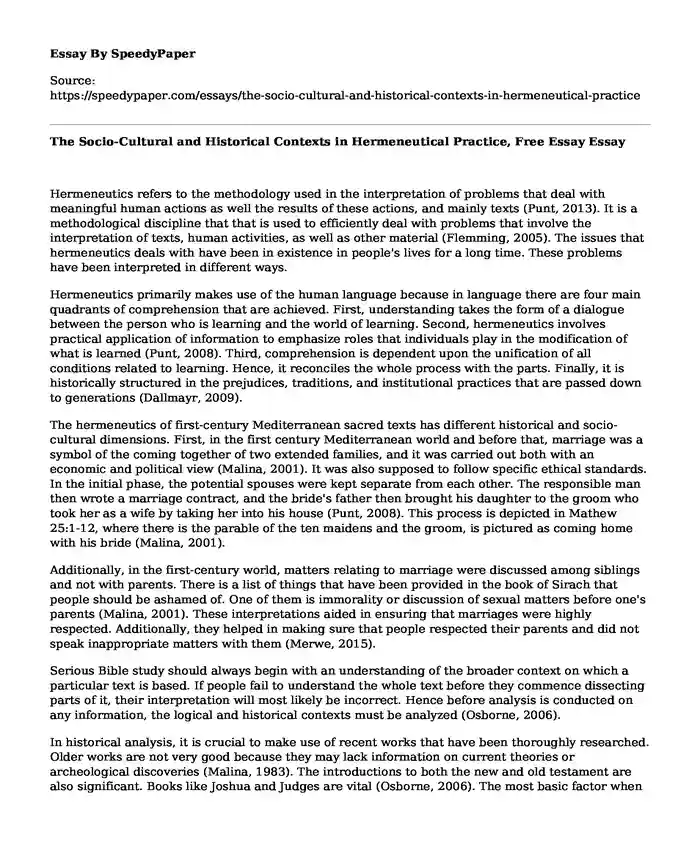Hermeneutics refers to the methodology used in the interpretation of problems that deal with meaningful human actions as well the results of these actions, and mainly texts (Punt, 2013). It is a methodological discipline that that is used to efficiently deal with problems that involve the interpretation of texts, human activities, as well as other material (Flemming, 2005). The issues that hermeneutics deals with have been in existence in people's lives for a long time. These problems have been interpreted in different ways.
Hermeneutics primarily makes use of the human language because in language there are four main quadrants of comprehension that are achieved. First, understanding takes the form of a dialogue between the person who is learning and the world of learning. Second, hermeneutics involves practical application of information to emphasize roles that individuals play in the modification of what is learned (Punt, 2008). Third, comprehension is dependent upon the unification of all conditions related to learning. Hence, it reconciles the whole process with the parts. Finally, it is historically structured in the prejudices, traditions, and institutional practices that are passed down to generations (Dallmayr, 2009).
The hermeneutics of first-century Mediterranean sacred texts has different historical and socio-cultural dimensions. First, in the first century Mediterranean world and before that, marriage was a symbol of the coming together of two extended families, and it was carried out both with an economic and political view (Malina, 2001). It was also supposed to follow specific ethical standards. In the initial phase, the potential spouses were kept separate from each other. The responsible man then wrote a marriage contract, and the bride's father then brought his daughter to the groom who took her as a wife by taking her into his house (Punt, 2008). This process is depicted in Mathew 25:1-12, where there is the parable of the ten maidens and the groom, is pictured as coming home with his bride (Malina, 2001).
Additionally, in the first-century world, matters relating to marriage were discussed among siblings and not with parents. There is a list of things that have been provided in the book of Sirach that people should be ashamed of. One of them is immorality or discussion of sexual matters before one's parents (Malina, 2001). These interpretations aided in ensuring that marriages were highly respected. Additionally, they helped in making sure that people respected their parents and did not speak inappropriate matters with them (Merwe, 2015).
Serious Bible study should always begin with an understanding of the broader context on which a particular text is based. If people fail to understand the whole text before they commence dissecting parts of it, their interpretation will most likely be incorrect. Hence before analysis is conducted on any information, the logical and historical contexts must be analyzed (Osborne, 2006).
In historical analysis, it is crucial to make use of recent works that have been thoroughly researched. Older works are not very good because they may lack information on current theories or archeological discoveries (Malina, 1983). The introductions to both the new and old testament are also significant. Books like Joshua and Judges are vital (Osborne, 2006). The most basic factor when it comes to interpretation is the logical context of a text. Looking at both the historical and logical settings of a script is essential because the process of deriving meaning is complicated and this aids in exploring the complex interplay of an audience, the author, and the script (Dirkie, 2015).
Hermeneutics is thus essential because it enables people to overcome four main barriers. These include language, geographical, cultural, as well as time differences. Once people can interpret texts correctly, they can avoid making the wrong conclusions, they discern God's message to them and apply Biblical teachings to their lives.
Questions
1. What are the aspects of hermeneutic phenomenology? Are they exploratory or notional ?
2. What are the limitations of hermeneutics?
References
Dallmayr, F. (2009). Hermeneutics and inter-cultural dialog: linking theory and practice.
Dirkie, S. (2015). Reading the Bible through the ages? Historical and hermeneutical perspectives.
Flemming, D. (2005). Contextualization in the New Testament: Patterns for Theology and Mission. IVP, Downers Grove.
Malina, B. (1983). The New Testament World: Insights from Cultural Anthropology. Journal for The Study of the New Testament.
Malina, B. (2001). The New Testament World: Insights from Cultural Anthropology. (3rd ed.). Westminster John Knox Press.
Merwe, D. (2015). Reading the Bible in the 21st century: Some hermeneutical principles.
Osborne, G. (2006). The Hermeneutical Spiral: A Comprehensive Introduction to Biblical Interpretation. IVP Academic.
Punt, J. (2008). Paul and postcolonial hermeneutics: Marginality and/in early biblical interpretation.
Punt, J. (2013). The interpretation of the New Testament as the study of texts and contexts: Hermeneutics, identities, communities.
Robbins, V. (2004). Beginnings and Developments in Socio-Rhetorical Interpretation.
Cite this page
The Socio-Cultural and Historical Contexts in Hermeneutical Practice, Free Essay. (2022, Mar 09). Retrieved from https://speedypaper.com/essays/the-socio-cultural-and-historical-contexts-in-hermeneutical-practice
Request Removal
If you are the original author of this essay and no longer wish to have it published on the SpeedyPaper website, please click below to request its removal:
- Free Essay Example: To Write. To Read. To Live
- Free Essay Example on a Gay Marriage Issue
- Essay Sample on Seneca people
- Essay Sample on Innovative Delivery Care Models
- Free Essay Sample: Historical Background and Purpose of Interpol
- Free Essay: The Relationship Between an Adopted child and a Child Not Adopted in a Preschool in the US
- Essay Sample Analyzing the Cases of the Montes Calcados and Blackberry Companies
Popular categories





